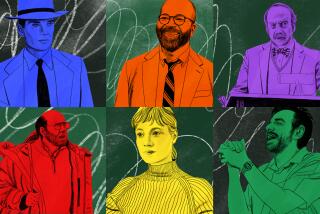Hi-Tech Teaching : Educators Learning That the Videodisc Can Be a Big Part of the Classroom Picture
- Share via
By her own admission, veteran high school English teacher Fran Oberman is one of those people who shy away from technology.
She dreads wrestling with those old classroom filmstrips and projectors, doesn’t operate the family VCR and until just recently had never even laid eyes on a videodisc.
Yet there she was last week, equipped with a borrowed videodisc player, expertly guiding her 10th-graders through the film version of Harper Lee’s Pulitzer Prize-winning novel, “To Kill a Mockingbird.”
“This is wonderful--especially for teaching writing,” enthused Oberman, who teaches at Taft High School in Woodland Hills. “You can do so much with it, and it’s so easy to use.”
Oberman’s experience does not surprise former junior high school English teacher and Cal State Northridge lecturer Martina E. Lewis. In her role as a supervisor for CSUN’s student teachers throughout Los Angeles and Ventura counties, she has tried to help her technology-shy colleagues see the light.
“We English teachers are notorious for being afraid to use technology,” Lewis said. “I was in one school that had a nearly new disc player just sitting in a closet somewhere because nobody knew what to do with it.”
Lewis is convinced that the videodisc can easily and inexpensively enhance the teaching of writing, literature and other language arts. She has been working informally with dozens of teachers, writing study guides (to be published this fall by Pasadena-based Media Learning Systems), demonstrating techniques and lessons, helping compare the features of various models of disc players. She even lends her own equipment on occasion, lugging TV set, player and a small library of discs from school to school. Some schools have bought videodisc players after their English teachers tried Lewis’ methods.
Lewis cites several reasons for her fervor about teaching via the videodisc, which looks like a silver-toned LP record. Its thousands of frames are read by a light beam in the player, which can be plugged into a television set and controlled by a single remote-control key pad, thus eliminating the need for a lot of expensive equipment.
Because nothing touches the data stored on the disc, it does not wear out or become distorted with use. Some forms can provide pictures that can be “frozen” on the screen indefinitely.
And, unlike videotape, any frame on a disc can be called up within four seconds, giving users increased flexibility. (Oberman, for example, was able to quickly find and display seven examples of prejudice in the video version of the novel her class was studying, the story of a black man wrongly accused of raping a white woman in the Depression-era South.)
Highly sophisticated “interactive” videodiscs--which require computer terminals and other costly equipment to enable students to respond individually to material being taught--have been used in industry and military training classes for several years and are increasingly available for school use.
But Lewis said she has found most teachers are not ready for high-level interactivity yet, nor can their districts afford it.
“I started out interested in the highest level of interactivity, but when I saw the need and how it was being used, I knew it had to be brought down to a level that was more affordable and more understandable,” Lewis said.
So she has devised ways to use commonly available videodiscs in the classroom. Much of the material taught in California’s junior and senior high schools--such as Shakespeare’s “Romeo and Juliet,” Reginald Rose’s “Twelve Angry Men” and “The Diary of Anne Frank”--have been made into films. A number of them have been recorded on videodisc, increasingly available for home use, and can be rented or bought at many video stores.
Teamed with other videodiscs, such as those of Grolier’s Encyclopedia or a history of the National Gallery of Art, Lewis said, these works can be used in conjunction with reading to create custom-tailored instruction.
By going through the work on videodisc, a teacher can note scenes or concepts and create lessons that can be adapted for all ability levels, designed for group learning or tailored for an individual student. Today’s technology-wise students can use the videodiscs to choose and launch their own research projects.
The videodisc allows students to make detailed comparisons between book and movie versions, study character and plot development and build writing assignments based on material pulled from the videodisc.
No one has conducted formal tests yet to see how these types of videodiscs affect student learning. Yet teachers such as Oberman are pleased with their classroom results.
Her racially integrated class spent a day looking for clues to the innocence of “Mockingbird’s” accused rapist. Taking turns operating the controls, the students searched for information about the novel’s setting and used the Grolier’s disc to look up such concepts as prejudice and discrimination. They viewed examples of racial segregation and wrote brief essays on incidents of discrimination that they had witnessed.
“Do you know the difference between between prejudice and discrimination?” Oberman asked a student who had been working with the Grolier’s disc.
“Prejudice is an attitude,” the youth replied. “Discrimination is how you show it. It’s behavior.”
More to Read
Sign up for Essential California
The most important California stories and recommendations in your inbox every morning.
You may occasionally receive promotional content from the Los Angeles Times.














